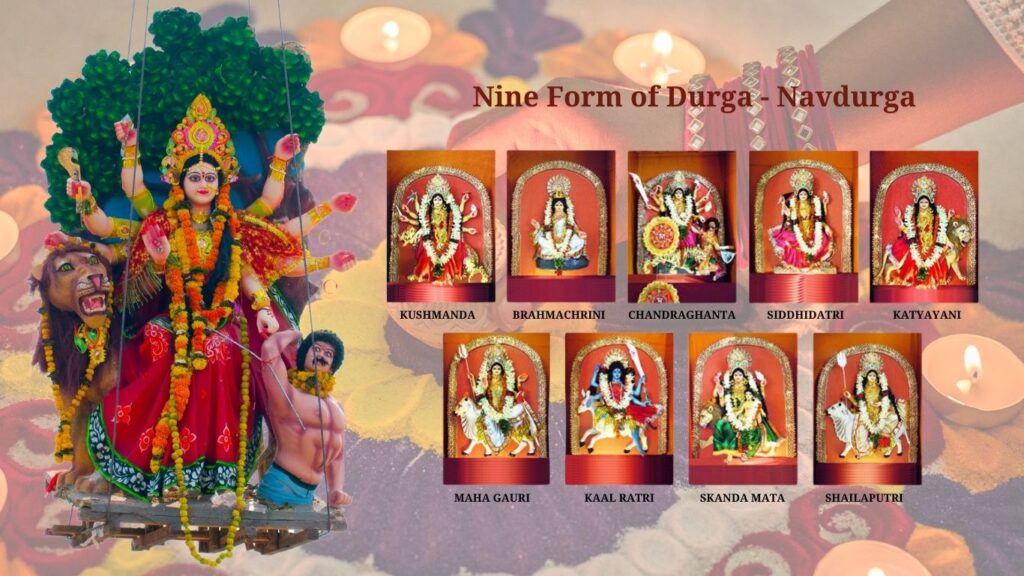
Mata Kalaratri – The Dark Night
Mata Kalratri is the seventh and one of the most intense forms of Goddess Durga, representing the fierce aspect of the Divine Mother. As her name suggests, “Kal” refers to time and death, and “Ratri” means night. Mata Kalratri, therefore, is the goddess who brings an end to the dark forces of time and ignorance, and destroys the negativity that hinders spiritual growth. She is revered as the one who liberates her devotees from the darkness of ignorance and fear, leading them to enlightenment and courage.
The Symbolism of Mata Kalratri
Maa Kalratri’s form is both fearsome and powerful. Her dark complexion symbolizes the vast and all-encompassing nature of time and death, which no one can escape. She rides a donkey, a humble and unassuming creature, emphasizing that she is beyond vanity and worldly grandeur.
Her appearance is fierce, with long, unbound hair flowing wildly, symbolizing freedom and liberation from earthly constraints. She has four hands: in her left hands, she holds a cleaver and a burning torch, symbols of destruction of ignorance and illumination of truth, respectively. Her right hands are in Varada Mudra (blessing) and Abhaya Mudra (protection), signifying that despite her terrifying form, she offers protection and blessings to her devotees.
Maa Kalratri’s three eyes radiate intense light, resembling flashes of lightning that cut through the darkest of nights. Her breath releases flames from her nostrils, representing the fiery nature of destruction she embodies. She is adorned with a necklace that shines like thunder, further amplifying her ferocity. Despite her frightening appearance, to her devotees, she is a source of immense courage, comfort, and calm.
The Deeper Significance of Mata Kalratri
Mata Kalratri teaches a profound lesson about the inevitability of life’s darker realities—sorrow, pain, destruction, and ultimately, death. These are the truths of existence that cannot be avoided or denied. She urges her devotees to accept these aspects of life with grace, as they are part of the greater cosmic balance. By acknowledging death and destruction, one can embrace the fullness of life and realize their true potential.
Maa Kalratri represents the cycle of time—birth, life, decay, and death—and teaches that destruction is not the end, but a necessary part of the process of renewal and transformation. Through her, devotees learn to face their fears and conquer the darkness within themselves, allowing them to attain spiritual growth and liberation.
The Mantra to Worship Maa Kalratri
To invoke the blessings of Maa Kalratri, devotees chant this powerful mantra:
वाम पादोल्ल सल्लोहलता कण्टक भूषणा |
वर्धन मूर्ध ध्वजा कृष्णा कालरात्रि भर्यङ्करी ||
Vāma pādōlla sallōhalatā kaṇṭaka bhūṣaṇā |
vardhana mūrdha dhvajā kr̥ṣṇā kālarātri bharyaṅkarī ||
This mantra helps devotees connect with the fierce yet protective energy of Maa Kalratri, seeking her guidance in overcoming obstacles, fears, and negativity in life.
The Day of Worship and Symbolism in Navratri
Maa Kalratri is worshipped on the seventh day of Navratri. Devotees dress in blue, red, and white colors on this day, as advised by Lord Ganesha. Each of these colors carries significance—blue symbolizes calm and wisdom, red signifies power and action, and white stands for purity and peace.
On this day, devotees meditate on the fact that pain, suffering, and death are part of the natural cycle of life. They pray for the strength to overcome fears and challenges, and to find peace in the acceptance of life’s unavoidable truths.
Conclusion
Mata Kalratri, with her fierce form and compassionate heart, teaches us the ultimate lesson of life—that we cannot escape darkness, destruction, and death, but through understanding and acceptance, we can overcome fear and ignorance. She is the destroyer of evil and negativity, bringing light where there is darkness, and guiding her devotees to courage and calm. By worshiping Maa Kalratri, devotees are blessed with the strength to face life’s adversities and the wisdom to embrace both the light and dark aspects of existence.
